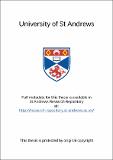Files in this item
The physics of microchip lasers : spatial and spectral selectivity mechanisms
Item metadata
| dc.contributor.advisor | Sinclair, B. D. (Bruce D.) | en |
| dc.contributor.author | Kemp, Alan | en |
| dc.coverage.spatial | 234p | en |
| dc.date.accessioned | 2021-04-08T08:56:57Z | |
| dc.date.available | 2021-04-08T08:56:57Z | |
| dc.date.issued | 2000 | |
| dc.identifier.uri | https://hdl.handle.net/10023/21811 | |
| dc.description.abstract | This thesis describes an experimental and theoretical exploration of some of the physics of microchip lasers and micro-lasers, with particular reference to the selection of the transverse and longitudinal modes. The guiding of the transverse mode in Nd:YVO₄ and Nd:YAG microchip lasers is examined at pump powers well above threshold. In Nd:YAG, the guiding is found to be purely thermal. However, in Nd:YVO₄ there is found to be a significant gain-related component to the guiding. This is the first time such an effect has been observed in a continuous wave, four-level microchip laser away from threshold. Modelling of the gain-related and thermal effects gives good agreement with experiment. A Jones matrix formalism is used to understand the polarisation and longitudinal mode structure in frequency doubled microchip lasers and micro-lasers. Such modelling of a frequency doubled microchip lasers gives good agreement with experiment and represents a starting point in understanding the unusual intensity stability properties of these lasers. The Jones matrix model is also applied to the design of single frequency micro-lasers utilising a birefringent filter and having a birefringent gain crystal. This is the first time that birefringent filtering in such lasers has been fully studied. The results of the modelling indicate the importance of the choice of birefringent material in the birefringent filter and its length. The length of the laser cavity and the birefringence of the gain material are also shown to be very important. Utilising the results of this modelling, a single frequency green laser based on Nd:YVO₄ and KTP was designed and built. More than 230 mW of single frequency green was produced in a high quality beam (M-squared less than 1.1) for 1.2 W of laser-diode pump power. Tuning of more than 20 GHz was demonstrated for 0.5 W of laser-diode pump power. | en |
| dc.language.iso | en | en |
| dc.publisher | University of St Andrews | en |
| dc.subject.lcc | TK7872.L3K4 | |
| dc.subject.lcsh | Lasers | en |
| dc.title | The physics of microchip lasers : spatial and spectral selectivity mechanisms | en |
| dc.type | Thesis | en |
| dc.type.qualificationlevel | Doctoral | en |
| dc.type.qualificationname | PhD Doctor of Philosopy | en |
| dc.publisher.institution | The University of St Andrews | en |
This item appears in the following Collection(s)
Items in the St Andrews Research Repository are protected by copyright, with all rights reserved, unless otherwise indicated.

